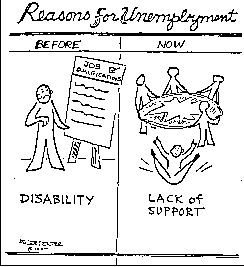Supported Employment
MANY TRADITIONAL PROGRAMS teach people skills to match the needs of some future job.
SUPPORTED EMPLOYMENT PROGRAMS:
find jobs that match the person as she or he is now.
Who is Supported Employment for?
Supported Employment is providing long-term supports for people to hold jobs in the community. People who have multiple disabilities, intellectual disabilities, autism, physical disabilities, mental illness, brain injuries, behavior disorders, and other disabilities can be included in supported employment programs regardless of the degree of disability they may have.
-
(NOTE: For individuals with more significant disabilities Customized Employment would likely be the more appropriate approach to employment opportunities as it is designed to meet both the specific abilities of the individual with a significant disability and the business needs of the employer)
Supported Employment is:
-
-
-
- Paid Work
- Intensive on-going support
- Integrated Work Sites
-
-
How are job openings found?
Traditional service provider roles are redefined, their role is to arrange for jobs rather than to teach prevocational skills and/or to provide employment in segregated settings.
In supported employment, the role of the service provider is to find a job opening in the community for a person, regardless of the “severity” of his or her disability.
-
-
-
-
Analyzing Job Requirements
-
-
-
When a job opening is found, the service provider figures out what skills are needed to do the specific job task. These could be things like:
-
-
-
- being able to follow directions
- knowing right from left, or
- being able to work at a task for several hours.
-
-
The service provider also finds out what job-related activities are needed to successfully keep a job. These could be things like:
-
-
-
- tolerance for noise
- calmness under pressure, or
- good grooming habits.
-
-
How is a person matched to a job?
Developing a Personal Work profile to find jobs that match the person as she or he is now.
All the features of a person and his/her living situations that relate to holding a job are included in an evaluation
Supported employment changes the focus of an evaluation from those things a person cannot do to all those things the person can do.
In addition to looking at a person’s skills and abilities, an evaluation looks at a person’s likes and dislikes about kinds of work and work situations.
A person’s living situation is also examined. For example, can the time of the person’s evening meal change to allow him or her to work at night? Do the person’s parents feel certain kinds of jobs are unacceptable?
The types of supports a person is likely to need in a workplace are also evaluated. Support might include a co-worker who is willing to accept responsibility for assisting a supported employee with a physical disability in case of emergency. Another type of support might be a training program from the service provider to help a worker learn to express anger in an acceptable way.
How is a person trained for the job?
– at the actual work site –
the skills needed to do a specific job.
The person from the agency providing support services
who does the on-the-job training
is usually called a job coach.
The Job Coach:
|
|
|
|
How is employment maintained?
-
-
Providing Ongoing Evaluation and Long-Term Support
-
In supported employment, the service provider also makes available
the kind of ongoing evaluation and long-term support
A person needs to STAY employed.
| The service provider helps the person in many situations: | Other responsibilities of the job coach are: |
|
|
Does the form of support differ for individuals?
that provide supported employment services
are the same
regardless of the disability of the person being served.
-
-
- Finding a Job Opening
- Analyzing Job Requirements
- Developing a Personal Work Profile
- Matching the Person with the Job
- Doing On-the-Job Training
- Providing Ongoing Evaluation and Long-Term Support
-
 However, the forms of support in each of the six areas may be different according to a supported employee’s disability.
However, the forms of support in each of the six areas may be different according to a supported employee’s disability.
For instance, a worker with mental retardation may need the support of an on-the-spot job coach to learn a skill needed for his or her job. The support needed by an employee with mental illness might be ongoing access to off-site counseling services to help develop ways of dealing with job stress.
In any case, the purpose of support services is to enable a person to get a job and stay employed. What is important is that the methods of support successfully meet the particular needs of the individual, regardless of his or her disability.
How is supportive employment part of the larger picture?
Participating in new activities and gaining new experiences adds richness and quality to people’s lives.
Persons with disabilities have a basic right to participate in the mainstream of life. They are not the only ones who can gain from these experiences – society will benefit from their participation.
Susan Schonfeld, Executive Director of Community Integrated Services
520 N Columbus Blvd. Suite 601 Philadelphia, PA 19123
Supporting Philadelphia and Montgomery County.
Call (215) 627-3550 to speak with an Employment Training Specialist
Additional Resources
National Disability Institute
DISCOVERY & CUSTOMIZED EMPLOYMENT
Discovery is the foundation of Customized Employment. It is a proven evidence-based practice that improves employment outcomes for youth and adults with disabilities. Discovery opens doors to employment for people who experience barriers to employment. The Discovery process enables youth and adults with disabilities and others to find a job that is a good fit with an employer who values and needs the talents they have to offer.
